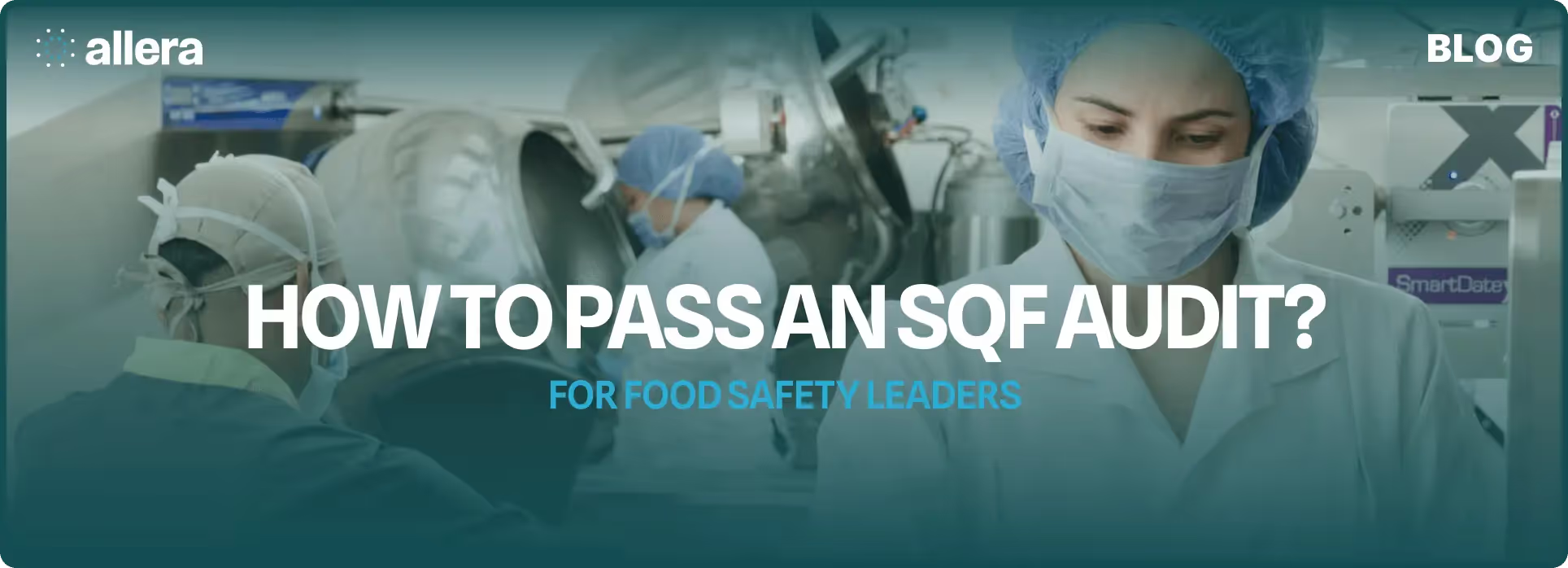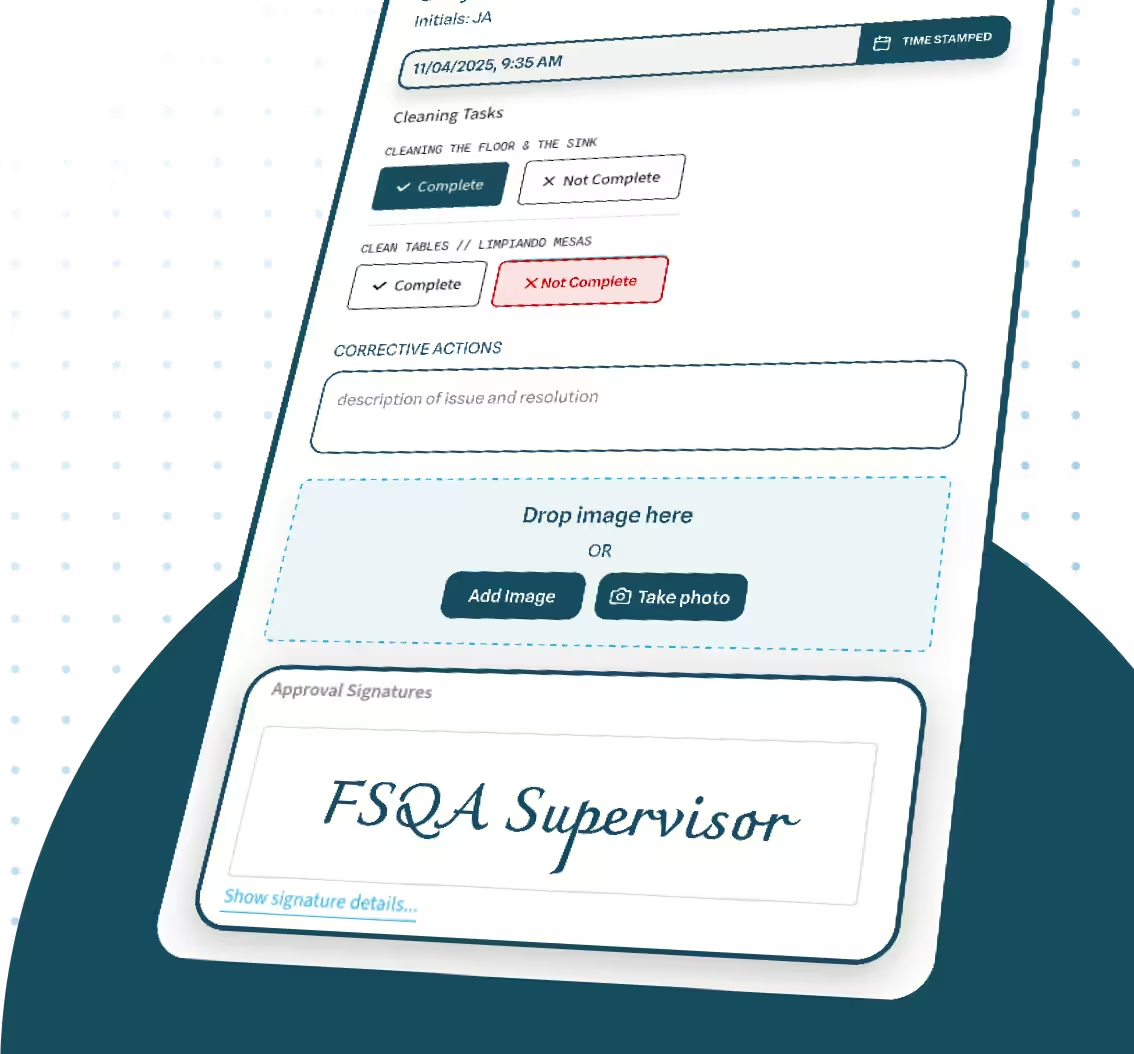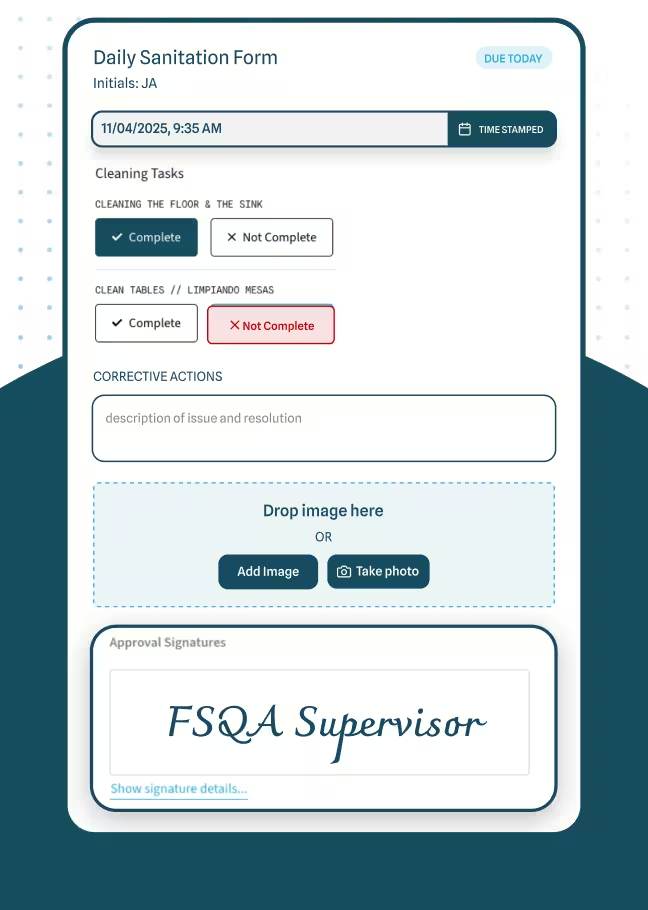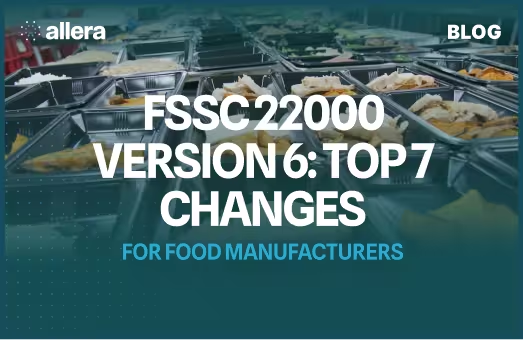

How to Pass an SQF Audit: A Practical Guide

Key Takeaways
- Register your site in the SQF database, define your certification scope, and appoint a qualified SQF practitioner before scheduling your audit.
- Maintain at least 90 days of accurate, organized documentation covering food safety plans, SOPs, supplier approvals, and training records.
- Conduct internal audits and fix any gaps promptly to minimize nonconformities during the official inspection.
- Be ready to address audit findings quickly with documented corrective actions to secure a high score and pass certification.
Read on to see how each takeaway works in practice, so you can confidently pass your SQF audit.
If you handle food safety in a manufacturing setting, you have probably encountered the term “SQF audit.” Good news, this is easier to navigate than it might seem. SQF (Safe Quality Food) is a globally recognized food safety and quality certification program designed to help you demonstrate safe, high-standard operations. Over 14,000 sites in more than 40 countries hold SQF certifications (SQFI), and many leading retailers insist you have one before stocking your products. By the end of this guide, you will have a clear picture of the SQF audit process, from setting up your scope to maintaining your recertification. Let’s get started.
What Is an SQF Audit and Why It Matters
An SQF audit is a formal evaluation of your site’s compliance with the SQF Code (Edition 9, as of now, with Edition 10 scheduled for release in mid to late August 2025) (SQFI). This code covers a wide range of requirements, including management practices, documentation, good manufacturing practices, and more. Here is why that matters:
- SQF is recognized by the Global Food Safety Initiative (GFSI) for meeting stringent food safety standards (SQFI).
- Many retailers trust SQF certification as proof of top-notch compliance.
- Customers and trading partners gain confidence in your brand because you are following verifiable best practices.
Core SQF Fundamentals
Before you schedule your first audit, you should understand three fundamental aspects that set SQF apart:
- Global acceptance: SQF is benchmarked to GFSI requirements. In other words, your certificate holds weight around the world.
- Flexible certification levels: Different SQF programs—Food Safety Fundamentals, the main Food Safety Code, and the Food Quality Code—let you choose a path that meets your unique operations (QIMA Blog).
- Yearly renewal: SQF certification typically expires in 12 months, requiring re-registration and periodic audits to confirm ongoing compliance (QIMA Blog).
SQF Code Edition 9: Key Requirements
The SQF Code, currently at Edition 9, is a set of requirements your facility must meet to become certified. It incorporates:
- Management commitment: Leaders at your site must show active involvement in food safety practices.
- Document control: Organized, up-to-date records of procedures, logs, and protocols.
- HACCP: Hazard Analysis and Critical Control Point is a system for identifying potential hazards and controlling them.
- Food defense: Safeguards against intentional adulteration or contamination.
- Allergen management: Measures to avoid cross-contact with allergens.
The SQF Code is also industry-specific. Whether you handle primary production or packaging, there is a code tailored to your scope. This ensures targeted guidance for diverse segments of the food supply chain (SQFI).
How to Prepare for an SQF Audit
You do not want surprises on your first SQF inspection. A well-organized approach typically leads to a smoother audit and fewer nonconformities.
Steps to get started
If you are brand new to SQF certification, here are the main steps:
- Site registration: You must register your facility in the SQF database. This helps create an official record of your audit intentions (FSNS).
- Designate an SQF practitioner: A qualified employee, knowledgeable in HACCP and the SQF Code, to monitor your entire program.
- Determine the scope: Figure out which areas of your operation and which food sector categories will be included (SQFI).
- Document and implement the SQF system: Prepare written policies, procedures, and specifications, then put them into action.
- Optional pre-assessment: You can request a pre-audit to highlight gaps early so you have time to fix them.
Each step lays a foundation for a clean, auditable process. Skipping any of these is like leaving a critical puzzle piece off the table, so tackle each point methodically.
Define Your Audit Scope the Right Way
One of the earliest decisions you will make is the scope of certification. The scope includes exactly what products, processes, and facilities the audit will cover. When you define your scope:
- Double-check any unique risk factors in your products.
- Include all relevant processes—ingredient receiving, storage, production lines, packaging, or distribution.
- Make sure the scope is accurate and agreed upon with your certification body (SQFI).
There is no single “right” scope for everyone. Some businesses may prefer to start small, certifying one production line at a time, while others certify an entire facility at once.
Must-Have Documentation for Audit Day
Organized, complete documentation saves you plenty of stress when audit day arrives. These resources often include:
- Food Safety Plan: A hazard analysis plus critical control points (HACCP) or HARPC (Hazard Analysis and Risk-Based Preventive Controls) summary.
- Standard Operating Procedures (SOPs): Detailed instructions for sanitation, equipment cleaning, and other tasks.
- Supplier Approval Program: Verified criteria for choosing and reviewing suppliers of raw materials (QIMA).
- Employee Training Records: Logs showing your workforce is trained on critical safety standards (SQFI).
- Corrective Action Logs: Written records of issues you found earlier and how you solved them.
As a rule, the SQFI recommends having at least 90 days of records on hand before your official SQF audit (SQFI). These records prove consistency and confirm that your written protocols are more than just words on paper.
The SQF Audit Process Step-by-Step
Once your facility is prepped, it is time for the official review. The SQF audit is conducted by a certification body (CB), often referred to as a third-party auditor. Expect this step to be thorough.
The official phases
While each certification body may have minor differences in scheduling or administrative steps, the framework is fairly standard:
- Pre-auditing steps: Site registration is complete, you have documented your system, and you have an SQF practitioner in place.
- Initial audit: The SQF auditor visits your site, reviews documents, interviews staff, checks facility conditions, and evaluates your actual practices against the SQF Code (FSNS).
- Corrective actions for nonconformities: If the auditor finds gaps, you receive a written list of nonconformities. You must fix them and show evidence of improvement within a specified time frame.
- Review and approval: The auditor checks your corrective actions. If satisfied, the audit report is passed for a technical review.
- Certification decision: Based on your final score, you receive an official grade—Excellent (E), Good (G), Complies (C), or Fails to Comply (F) (QIMA).
Nonconformities explained
Nonconformities are basically audit findings that do not meet SQF Code standards. They are categorized as:
- Minor: A deviation that does not directly compromise food safety. Usually correctable quickly.
- Major: A more serious deficiency that could affect food safety, but immediate risk may be low if corrected promptly.
- Critical: A direct and significant threat to food safety. This can lead to an automatic failure if the problem is not resolved right away.
The time frame to correct nonconformities depends on their severity. Some corrections must be shown within days, while others allow a few weeks. The key is swift action and solid documentation.
How SQF Audit Scoring Works
Auditors calculate your final score using a deduction system. Each type of nonconformity subtracts a certain number of points from an initial total (QIMA). Your final result, combined with the nature of your findings, determines your grade:
- Excellent (E): Typically scores above 95. You will be re-certified annually.
- Good (G): Often in the 85–94 range. Also re-certified annually.
- Complies (C): Scores around 70–84. You will likely need a follow-up (surveillance) audit.
- Fails to Comply (F): Any score below 70. You will need major corrective actions before another audit.
An excellent or good rating means you can celebrate—but remember, your status must be renewed every year.
Staying Certified: Annual Renewal and Ongoing Compliance
Maintaining an SQF certification is not a one-and-done affair. You must stay consistent to keep that certificate valid. Annual renewal is mandatory, and in some cases (like a “C” rating), you will see a surveillance audit before your next full certification review.
Maintain ongoing compliance
Food safety management is an evolving process. The more energetic you are about daily upkeep, the smoother your recertification will be. Consider these best practices:
- Frequent internal audits: Brief, focused checks of each line or major area.
- Tight document control: Keep logs updated, track any changes, and generate daily or weekly sign-offs.
- Regular staff training: Update your team whenever you change processes, equipment, or ingredients.
- Supplier reviews: Check raw materials for safety. If you change suppliers, keep proper records.
If you find any issues between official audits, address them promptly. This not only protects your brand but also demonstrates strong management commitment for your next SQF audit.
Common SQF Audit Pitfalls to Avoid
While SQF aims to be straightforward, a few common mistakes can slow you down:
- Delaying corrective actions: If you let time slip, you risk bigger and more serious nonconformities.
- Forgetting to update documents: Each time you refine a procedure or introduce new equipment, document it.
- Insufficient training: When staff do not understand the “why” behind certain steps, compliance can slip.
- Poor housekeeping: Many major nonconformities come from overlooked sanitation details. A daily routine can cut these risks.
Ultimately, your site’s culture is your best line of defense. If everyone treats food safety as a shared responsibility, you will have fewer headaches when the auditor knocks on your door.
Your Next Steps Toward SQF Audit Success
After you complete the initial audit cycle, it is all about continuous improvement. Your certificate proves you meet global standards, but your day-to-day practices keep that status healthy.
Review of What We Covered
- Understand the basics: Know exactly what an SQF audit is and why it matters.
- Prepare with intent: Register, pick your scope, assign a qualified practitioner, and collect 90 days of records.
- Master the audit process: Be ready for a multi-phase review, from initial inspection to corrective actions.
- Stay certified: Conduct internal audits, keep your documentation consistent, and handle staff training regularly.
Pass your SQF Audit with Allera
At this point, you may feel ready to take on your SQF audit with confidence. Allera wants to help keep you ahead of the game. Allera helps food manufacturers like you maintain your daily records, organize your standard operating procedures, and streamline your training efforts. You can track documentation in real time and be fully prepared for audits, recertifications, and any updates to the SQF Code. This cuts your administrative burden and helps you focus on improving food safety at every level. If you are ready to level up your audit readiness, connect with Allera today to explore our tailored solutions.
"I highly recommend Allera to any organization wanting to streamline operations and boost efficiency. The platform is user-friendly, customizable, and integrates seamlessly without extra tools. With Allera, we digitized every form, implemented rules to prevent missed actions, and saved time on record management. Its built-in timestamps improved transparency, and audits are now stress free. The minimal training required made the transition easy, and the incredible support team gave us confidence every step of the way."
– Caitlin Edsall, Director of Food Safety at Eden Green (Case Study: How Allera Cut Eden Green’s SQF Audit Time by 75%)
FAQs
What is the difference between SQF and BRC audit?
Both are GFSI-recognized and widely accepted. SQF issues a numeric score with a rating; BRCGS issues letter grades. Documentation structure, terminology, and some clause expectations differ, but both require HACCP, PRPs, internal audits, CAPA, and senior management commitment; retailer preference often determines which scheme a site pursues.
What happens if you fail a SQF audit?
If the audit finds a critical nonconformity or enough major issues, certification is not granted (or a current certificate may be suspended). You must correct causes within defined timeframes and undergo a follow-up or re-audit before certification can be issued or reinstated; customers that require certification may pause approvals until you pass.
How do you become a SQF auditor?
To become an SQF auditor, you must meet specific education, work experience, and training requirements set by the SQF Institute. This includes a background in food safety, formal HACCP training, completion of the SQF Auditor Training Course, and registration through the International Register of Certificated Auditors (IRCA) or a similar recognized body. You must also work with an accredited certification body to perform audits.
Is SQF a third party audit?
Yes. SQF audits are conducted by licensed third-party certification bodies that are independent from the business being audited. This impartiality ensures credibility with regulators, retailers, and consumers.
What happens if you mess up an audit?
If an SQF audit uncovers non-conformities, the severity determines the outcome. Minor issues typically require corrective action within a set timeframe. Major or critical failures can result in failing the audit, suspension of certification, or requiring a full re-audit before certification can be granted or reinstated.
How hard is SQF?
SQF certification can be challenging because it requires strict compliance with detailed food safety and quality codes and ongoing documentation. Businesses with well-established HACCP plans, strong prerequisite programs, and a culture of food safety find the process more manageable, while those starting from scratch may face a steep learning curve.
How much does a SQF audit cost?
Most facilities can expect to pay between $3,000 and $6,000 for the audit itself, with additional costs for auditor travel, pre-audit consulting, and corrective actions. Larger or multi-site operations may see significantly higher costs.
What are the three principles of SQF?
The three core principles of SQF (Safe Quality Food) are food safety, quality management, and regulatory compliance.
- Food safety is the foundation of the program, focusing on the prevention of biological, chemical, and physical hazards that can threaten public health. This includes applying HACCP principles, maintaining proper sanitation, and implementing traceability systems to minimize the risk of contamination.
- Quality management ensures that food products are not only safe but also consistent, reliable, and aligned with customer expectations. Through standardized processes, recordkeeping, and continuous improvement, SQF helps businesses reduce waste, improve efficiency, and maintain product integrity across every batch.
- Regulatory compliance guarantees that food companies meet all relevant laws and international standards. This includes alignment with government agencies such as the FDA or USDA in the United States, as well as adherence to global frameworks like GFSI. By doing so, businesses reduce the risk of recalls, penalties, and market restrictions.
Together, these three principles create a comprehensive and integrated food safety management system. They protect consumers, build trust with retailers and buyers, and help businesses remain competitive in a highly regulated global food industry.

.avif)







.avif)

.avif)
